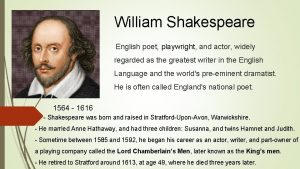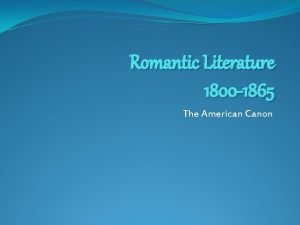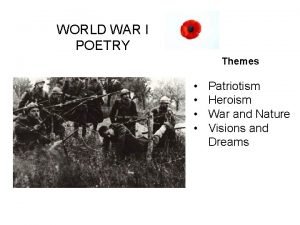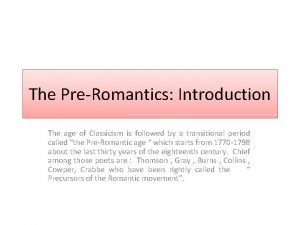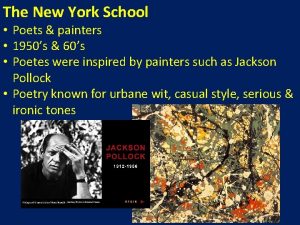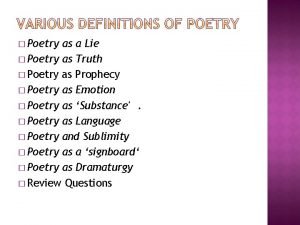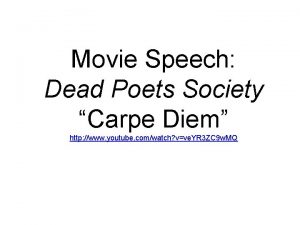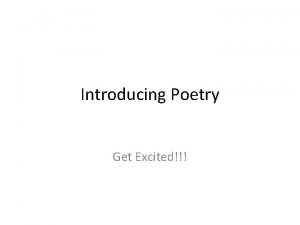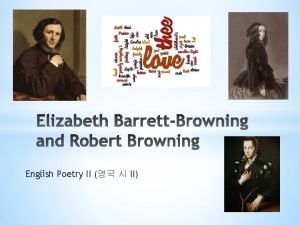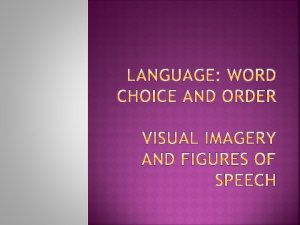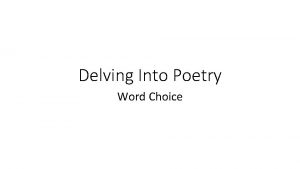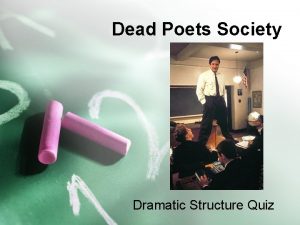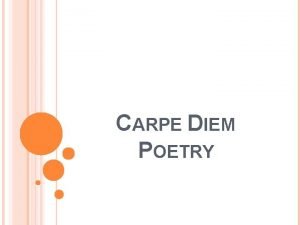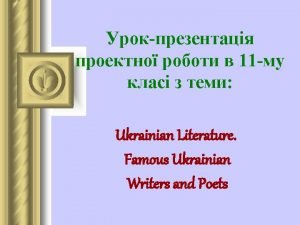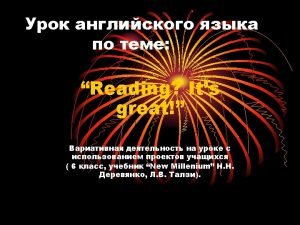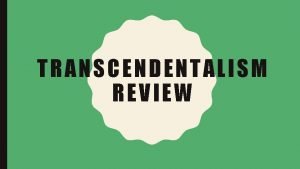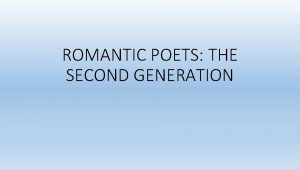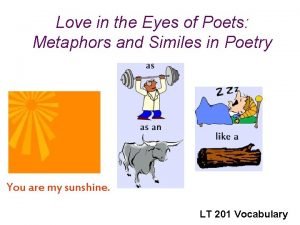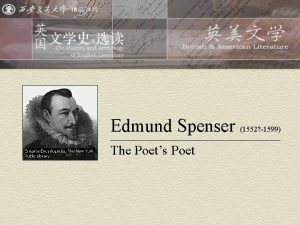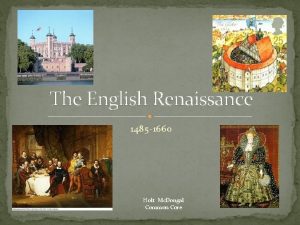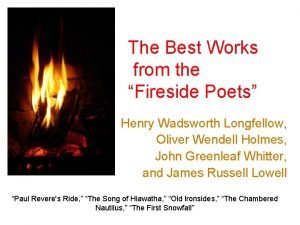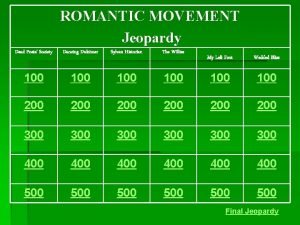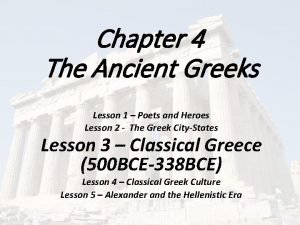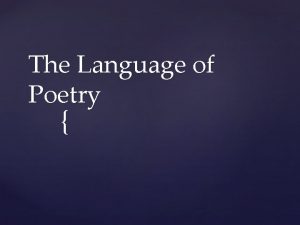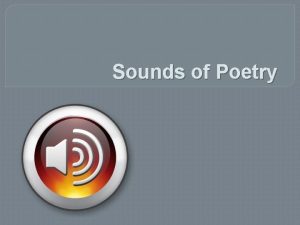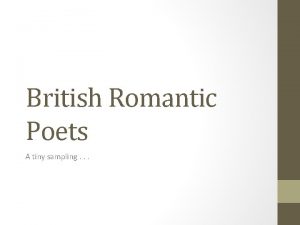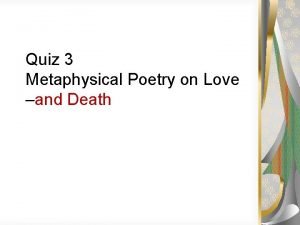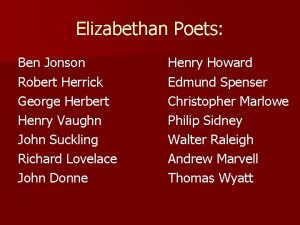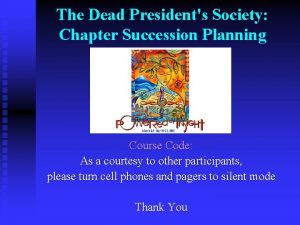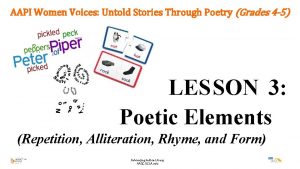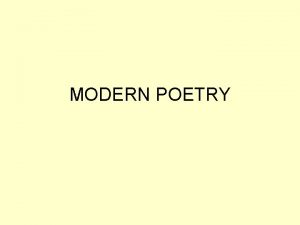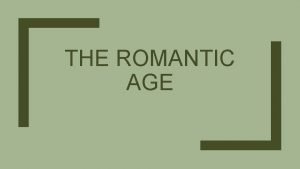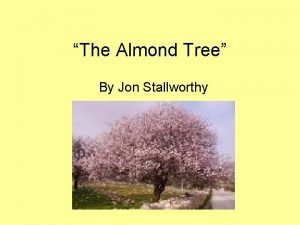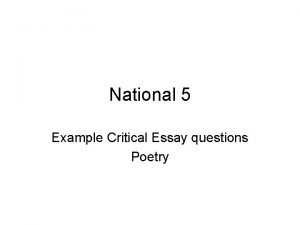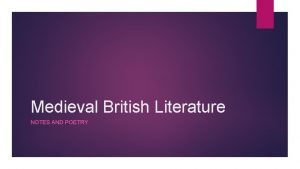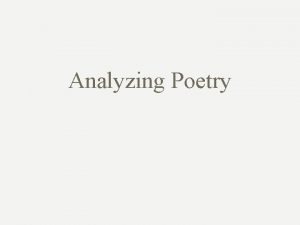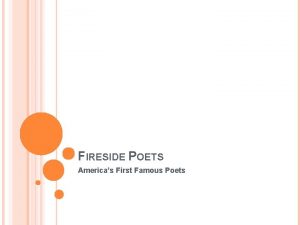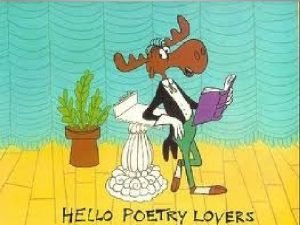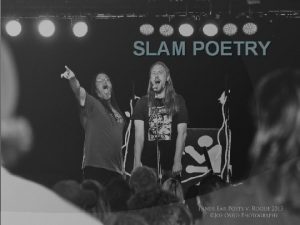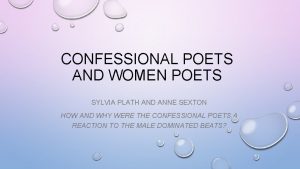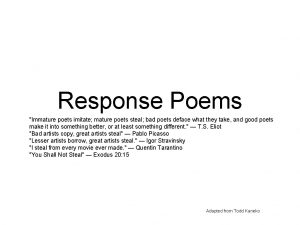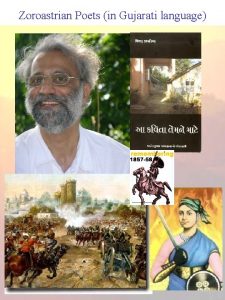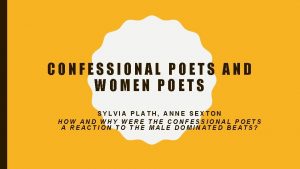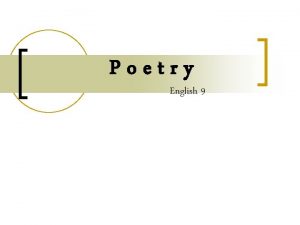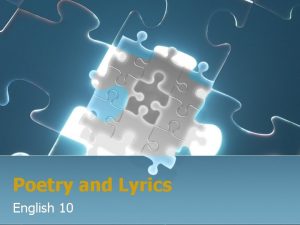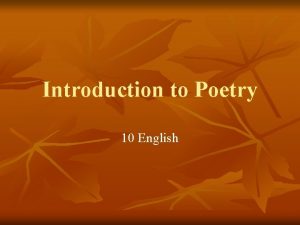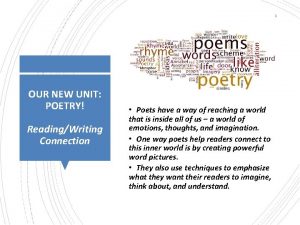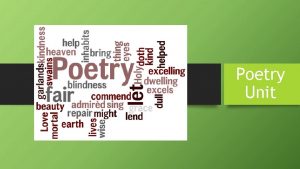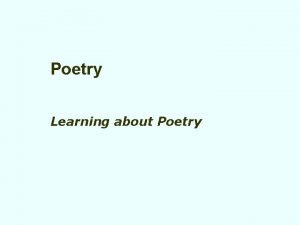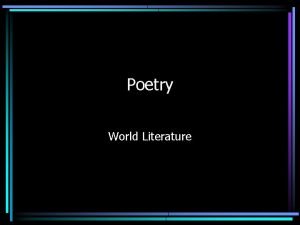Unit 6 Poetry English 12 Definition from Poets
















































- Slides: 48

Unit 6: Poetry English 12

Definition from Poets "Poetry is emotion put into measure. The emotion must come by nature, but the measure can be acquired by art. " --Thomas Hardy "Poetry is not an expression of the party line. It's that time of night, lying in bed, thinking what you really think, making the private world public, that's what the poet does. " --Allen Ginsberg "Poetry should surprise by a fine excess and not by singularity-- it should strike the reader as a wording of his own highest thoughts, and appear almost a remembrance. " --John Keats

What is Poetry? Poetry is a kind of language that says more and says it more intensely Goes beyond the practical or informational use of language and makes language about experience- a deeper and great awareness to understand our own experience in the world Clarifies experiences by using literary language (literary devices) In some poems, we also see persuasive language, or argument

Words, Words The average word has three component parts: sound, denotation, and connotation Notation- combination of tone and noises that make up a written word that has a meaning Denotation- the dictionary meaning attached to a notation (may be multiple- use context clues for specific meaning) Connotation- what the word suggests beyond what is expressed

The Writer and the Poet The writer uses language to communicate a message using one denotation at a time The poet often takes advantage of the many denotative meanings The poet seeks the most meaningful words to define the tone- grandiose or humble, fanciful or matter-of-fact, romantic or realistic, melodic or harsh. Poets economize a word– using it to the maximum of its potential. Writers who use words for informational texts only tap into a fraction of

Connotation Exercise Connotations can be positive or negative. Arrange the following words from most positive to most negative in connotation: A) skinny, thin, gaunt, slender A) Prosperous, loaded, moneyed, affluent A) Brainy, intelligent, egg-headed, smart

Imagery May be defined as the representation through language of sense experience, or sensuous details. Poets appeal to the following senses: Visual Gustatory Auditory Olfactory Tactile Kinesthetic Organic

Figurative Language A figure of speech is a way of saying something to mean something quite opposite. In other words, language that can not be taken literally.

Simile and Metaphor Simile and metaphor: used to compare things that are essentially unlike one another. Simile uses “like” or “as” whereas a metaphor substitutes a figurative for the literal term. The literal and figurative terms are respectively named and implied. In similes, both the literal and figurative terms are named. “Life is like a box of chocolates”

Forms of Metaphors Form 1: both the literal and figurative terms are named “Love is a Battlefield” Form 2: the literal term is named and the figurative term is implied. “Leaves got up in a coil and hissed/ Blindly struck at my knee and missed” Form 3: the literal term is implied and the figurative term is named. “It powders all the Wood/It fills with Alabaster Wool/The Wrinkles of the Road—”

Personification Gives attributes of human qualities to an animal, an object, or a concept. It is a subtype of metaphor– an implied comparison in which the figurative term is always a human being. “Time is a gentle thief” Plath personifies the mirror and lake because it speaks, thinks, and feels in “Mirror. ”

Symbolism allows people to communicate beyond the limits of language. A symbol is a person, place, or object that stands for something beyond itself. While a metaphor cannot be taken literally, a symbol can be seen as the literal, as well as the figurative. The symbol is often so general in its meaning that it can suggest a great variety of specific meanings.

Spot the Difference LITERAL, METAPHOR, or SYMBOL? “I saw a shaggy brown dog rubbing its back against a white picket fence. ” “Some dirty dog stole my wallet at the party. ” “You can’t teach an old dog new tricks. ”

Allegory is a narrative or description that has a second meaning beneath the surface. The main interest is in the ulterior meaning. Sometimes defined as an extended metaphor and sometimes a series of related symbols, it is neither. Rather, it is a system of related comparisons rather than one comparison drawn out. An effective way of making the abstract concrete.

The use of "music" in poetry The poet 1. chooses words for sound as well as meaning 2. use sound as a means to reinforce meaning A poet may sometimes pursues verbal music for its own sake, but in the best poetry the music is just a part; it contributes to the total meaning or experience

Repetition Poet may repeat any unit of sound from smallest to largest When such repetition is done according to a fixed pattern, it is called a refrain. individual vowel sounds and consonant sounds whole syllables words Phrases lines--"and miles to go before I sleep" or "Hurry up please, it's time to go, ” or a group of lines

Repetition of syllable sounds Alliteration: repetition of initial consonant sounds “safe and sound” Assonance: repetition of vowel sounds “mad as a hatter” Consonance: repetition of final consonant sounds “odds and ends” Assonance + consonance= rhyme

Rhyme Masculine rhyme: when the rhyme involves only one syllable, as in “support” and “retort” Feminine rhyme: when the rhyme sounds involve two or more syllables, as in “spitefully” and “delightfully” Internal rhyme: when one or more words are within the line of poetry End rhyme: when the rhyming words are at the end of a line Approximate rhymes (slant): sound similarity

Irony- Verbal irony- saying the opposite of what one means- different from sarcasm, which is intended to wound the feelings, and satire, which is a more formal term for sarcasm, applied to literature. does not intend to be cruel or kind: “Here’s some bad news for you: you all got As and Bs!” Is best when it is subtle, because it can be dangerous when misunderstood.

Irony- Dramatic In dramatic irony, the discrepancy is not between what the speaker says and what the speaker means, but between what the speaker says and what the poem means. The speaker’s words may be perfectly clear, but the author may be indicating to the reader an idea or attitude that is opposite to those the speaker is voicing. This form is more complex and therefore demands a more complex response from the reader.

Irony- Situation In situational irony, the discrepancy exists between the actual circumstances and those that would seem appropriate. For example, when Coleridge’s Ancient Mariner finds himself in the middle of the ocean with “Water, whatever, everywhere” but not a “drop to drink, ” the situation is ironic.

Overstatement and Understatement Overstatement, or hyperbole, is simply exaggeration, but in the service of telling a certain truth with added emphasis. “I’ll die if I don’t pass this course” Understatement, may emphasize the truth by understating it; may be more apparent in how one says it. “This looks like a nice snack” while sitting down to thanksgiving dinner. May be used to be humorous, grave, fanciful, or convincing.

Overstatement Example: If you were to leave me, if I were to fold only my own clothes, the convexes and concaves of my blouses, panties, stockings, bras turned upon themselves, a mountain of unsorted wash could not fill the empty side of the bed. (Excerpt from “Sorting Laundry” by Elisavietta Richie)

Understatement Example: Trying to protect his students’ innocence he told them the Ice Age was really just the Chilly Age, a period of million years when everyone had to wear sweaters. And the Stone Age became the Gravel Age, named after the long driveways of the time. The Spanish Inquisition was nothing more Than an outbreak of questions such as “How far is it from here to Madrid? ” “What do you call a Matador’s hat? ” (Excerpt from “History Teacher” by Billy Collins)

Rhythm is the pattern of stresses in a line of verse. When you speak, you stress some syllables and leave others unstressed. When you string a lot of words together, you start seeing patterns. Rhythm is a natural thing. It's in everything you say and write, even if you don't intend for it to be.

Pauses In addition to accent or stress, rhythm is also based on pauses. Pauses are a result of natural speech rhythms and the structure of sentences. Periods and commas create pauses, but so does the normal flow of phrases and clauses. End-stopped line: the end of a line corresponds with a natural speech pause Enjambment: the line moves on without pause into the next line Caesuras: a pause that occurs within a line, either grammatically or rhetorically.

Meter Traditional forms of verse use established rhythmic patterns called meters (meter means "measure" in Greek) Meter is a generally regular pattern of stressed ( / ) and unstressed (∨) syllables in poetry or verse. Just as we can measure distance in meters, we can measure the beats in a poem in meter. Each rhythmic unit is called a foot, the individual building blocks of meter.

Feet Here are the most common feet, the rhythms they represent, and an example of that rhythm. Anapest: duh-DUH “but of course!” Dactyl: DUH-duh “honestly” Iamb: duh-DUH “collapse” Trochee: DUH-duh “pizza”

Repetition of feet To build a line of verse, poets can string together repetitions of one of these feet. Such repetitions are named as follows: 1 foot: monometer 2 feet: dimeter 3 feet: trimeter 4 feet: tetrameter 5 feet: pentameter 6 feet: hexameter

Scansion To act of determining and graphically representing the metrical character of a line or verse: Stressed syllables are marked with a ( / ) above the syllable Unstressed syllables are marked with a (∨) above the syllable Each foot is separated by a line

Scan the following: But soft! What light through yonder window breaks Name it: The whiskey on your breath Name it: Had we but world enough, and time Name it:

The Purpose? Just as a poet might change the rhyme scheme for a specific purpose, a change in meter might indicate that the poet is trying to change the topic or make some other type of transition. Consistent meter also shows a high level of intelligence or status. Shakespeare usually had his noble characters (e. g. , kings, queens, generals, etc. ) speak in iambic pentameter, but his lower characters (e. g. , servants and peasants) would speak in regular language.

Terminology for Stanzas 2 lines: Couplet 3 lines: Tercet 4 lines: Quatrain 5 lines: Quintain 6 lines: Sestet 7 lines: Septet 8 lines: Octave

Forms of Poetry Ballad: narrative poem written in a songlike stanza form Blank Verse: unrhymed lines written in iambic pentameter Didactic: having the purpose to teach or preach. Elegy: a solemn, sorrowful poem or meditation about death in general or specifically for one who is dead Epic: a long, narrative poem that describes the history of a nation, community, or race

Forms of Poetry Epigram: A pithy saying, often using contrast. Free Verse: Poetry which is not written in a traditional meter but is still rhythmical. Lament: a poem that expresses grief, not necessarily about death Parable: a story designed to suggest a principle, illustrate a moral, or answer a question (allegorical) Parody: A composition that imitates the style of another composition normally for comic effect

Forms of Poetry Sonnet: Italian or Petrarchan: abba cdcdcd (14 lines - made up of an octave and sestet) Shakespearean: abab cdcd efef gg, iambic pentameter (14 lines made up of 3 quatrains and a couplet) Terza Rima: A three-line stanza rhymed aba, bcb, cdc (Dante's Divine Comedy)

REVIEW

Word Choice DENOTATION VS. CONNOTATION

IMAGERY

Figurative Language SIMILE METAPHOR PERSONIFICATION ALLEGORY

REFRAIN REPETITION

Sound Devices ALLITERATION ASSONANCE CONSONANCE

Rhyme MASCULINE FEMININE INTERNAL END SLANT/APPROXIMATE

Irony VERBAL DRAMATIC SITUATIONAL

OVERSTATEMENT VS. UNDERSTATEMENT

STANZAS

METER and RHYTHM

FORMS OF POETRY
 English poet and playwright
English poet and playwright Hong kong budding poets (english) award online platform
Hong kong budding poets (english) award online platform Fireside poets definition
Fireside poets definition English system of measurement
English system of measurement Unit 10, unit 10 review tests, unit 10 general test
Unit 10, unit 10 review tests, unit 10 general test Poem on online teaching
Poem on online teaching Dead poets society title
Dead poets society title Characteristics of pre- pomamtic poetry
Characteristics of pre- pomamtic poetry New york school poets
New york school poets Poets lie meaning
Poets lie meaning Dead poets society carpe diem speech
Dead poets society carpe diem speech Batter my heart mcq
Batter my heart mcq Performance poets
Performance poets Famous american poets
Famous american poets Biography of robert browning
Biography of robert browning What is diction in a poem
What is diction in a poem Poets choice of words
Poets choice of words Dead poets society quiz
Dead poets society quiz Carpe.diem meaning
Carpe.diem meaning Ukraine famous writers
Ukraine famous writers Us and british famous writers
Us and british famous writers Crown of thorns symbolism dead poets society
Crown of thorns symbolism dead poets society Second generation of romantic poets
Second generation of romantic poets Dead poets society metaphors
Dead poets society metaphors Jacobean and caroline age
Jacobean and caroline age Edmund spenser poets poet
Edmund spenser poets poet What did fireside poets write about
What did fireside poets write about Metaphysical poets focused on _____.
Metaphysical poets focused on _____. The fireside poets
The fireside poets John keats dead poets society
John keats dead poets society Chapter 4 lesson 1 poets and heroes
Chapter 4 lesson 1 poets and heroes It is the poet's choice of words
It is the poet's choice of words The watch poem by frances cornford
The watch poem by frances cornford Neoclassical poets
Neoclassical poets Which of the following is wrong about metaphysical poets
Which of the following is wrong about metaphysical poets Elizabethan poets
Elizabethan poets Dead poets society chapter 13
Dead poets society chapter 13 Cavalier poetry definition
Cavalier poetry definition Characteristics of romantic literature
Characteristics of romantic literature Aapi poets
Aapi poets Aapi poetry
Aapi poetry Experimentation in modern poetry
Experimentation in modern poetry Lyric poetry poetry
Lyric poetry poetry Augustan age characteristics
Augustan age characteristics The almond tree poem
The almond tree poem National 5 critical essay questions poetry
National 5 critical essay questions poetry Medieval poetry in english literature
Medieval poetry in english literature Flower poetry in english
Flower poetry in english Gcse edexcel english literature
Gcse edexcel english literature
